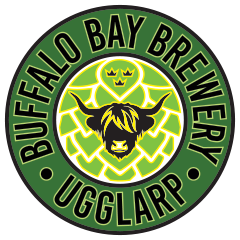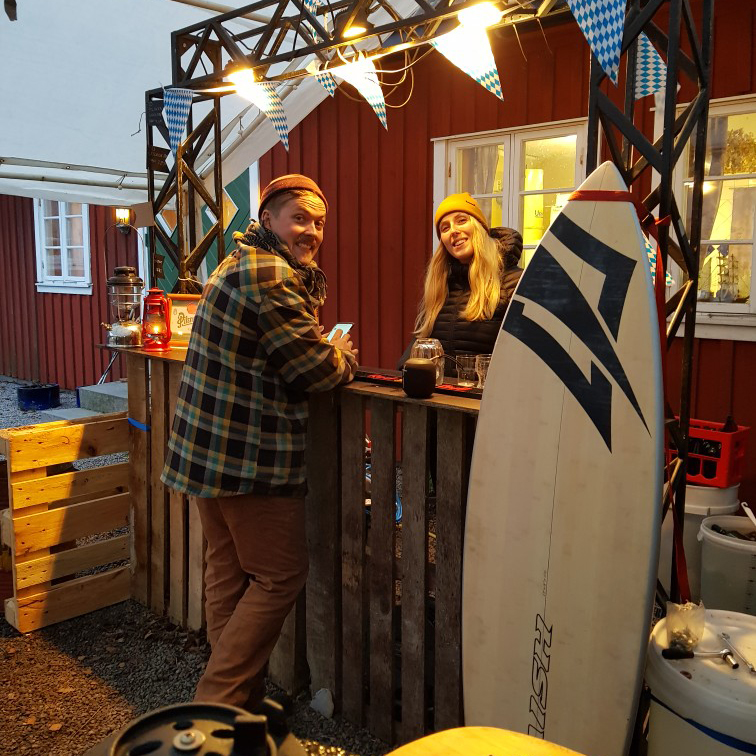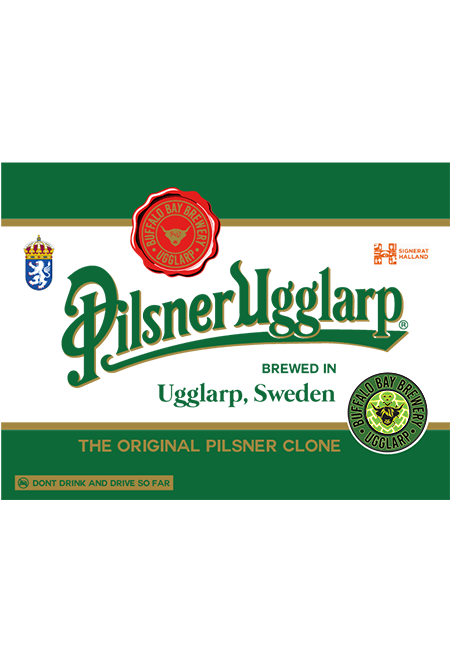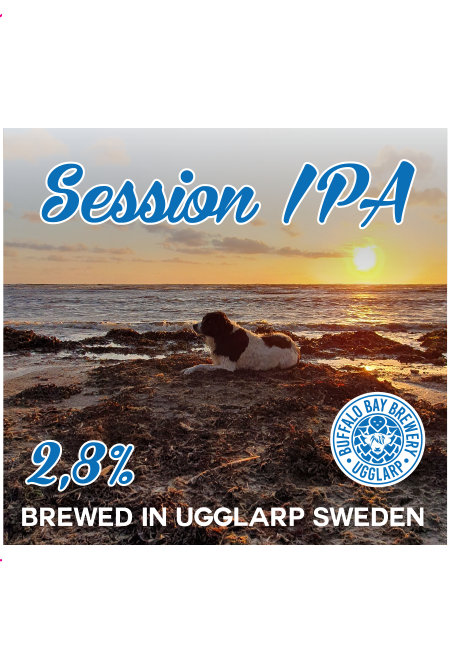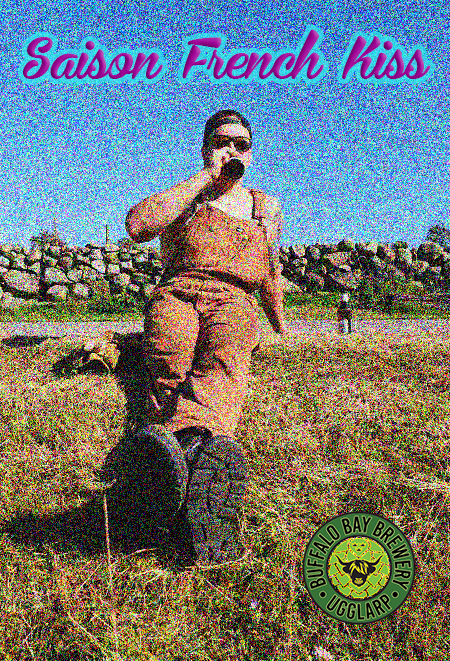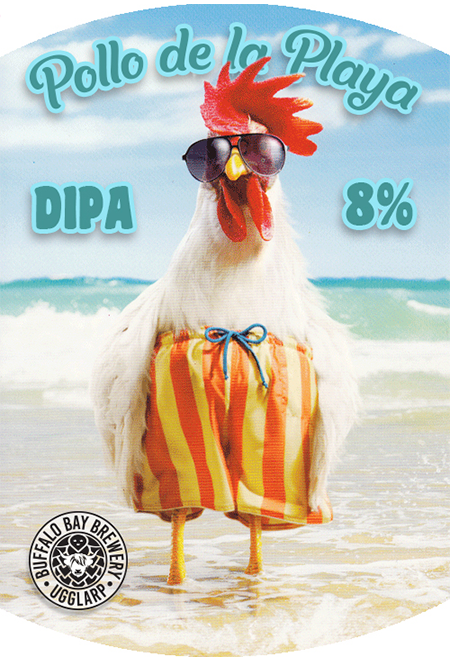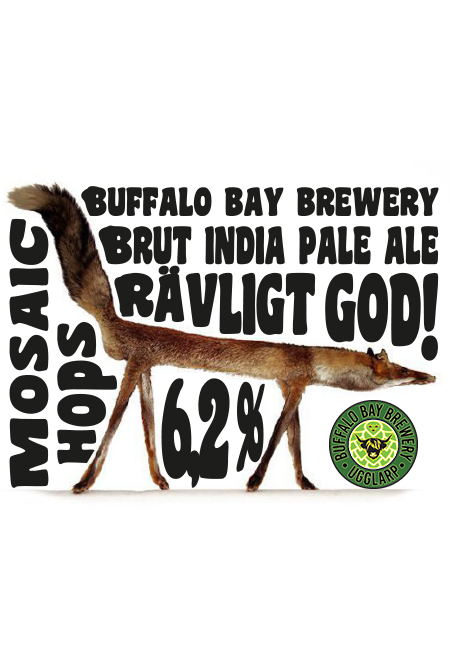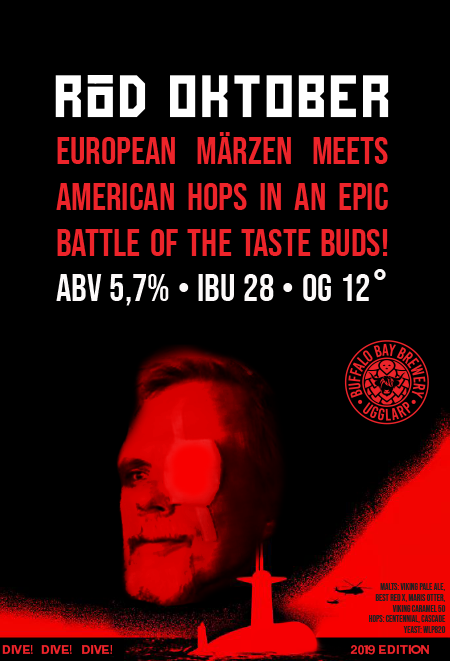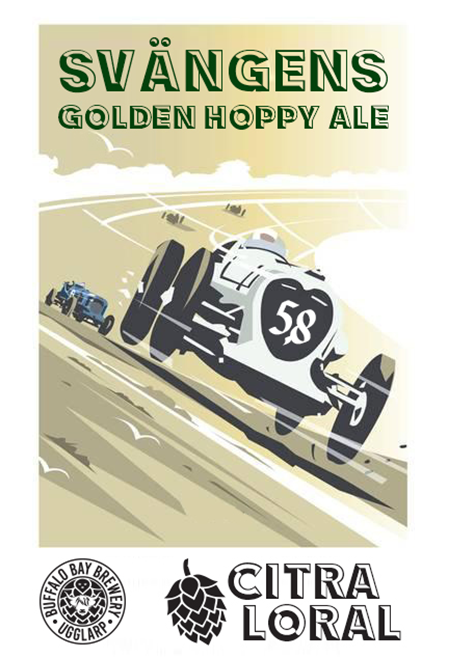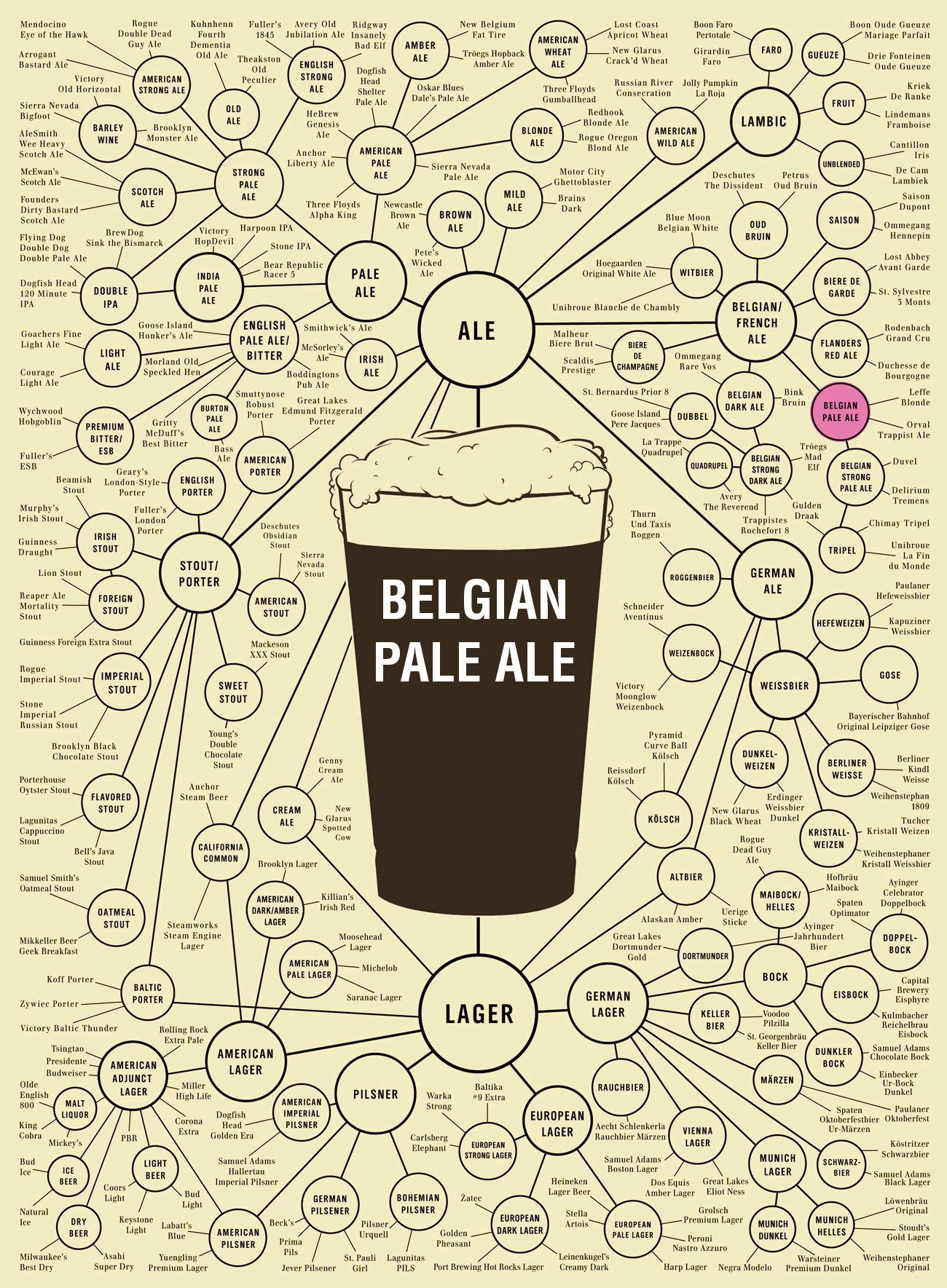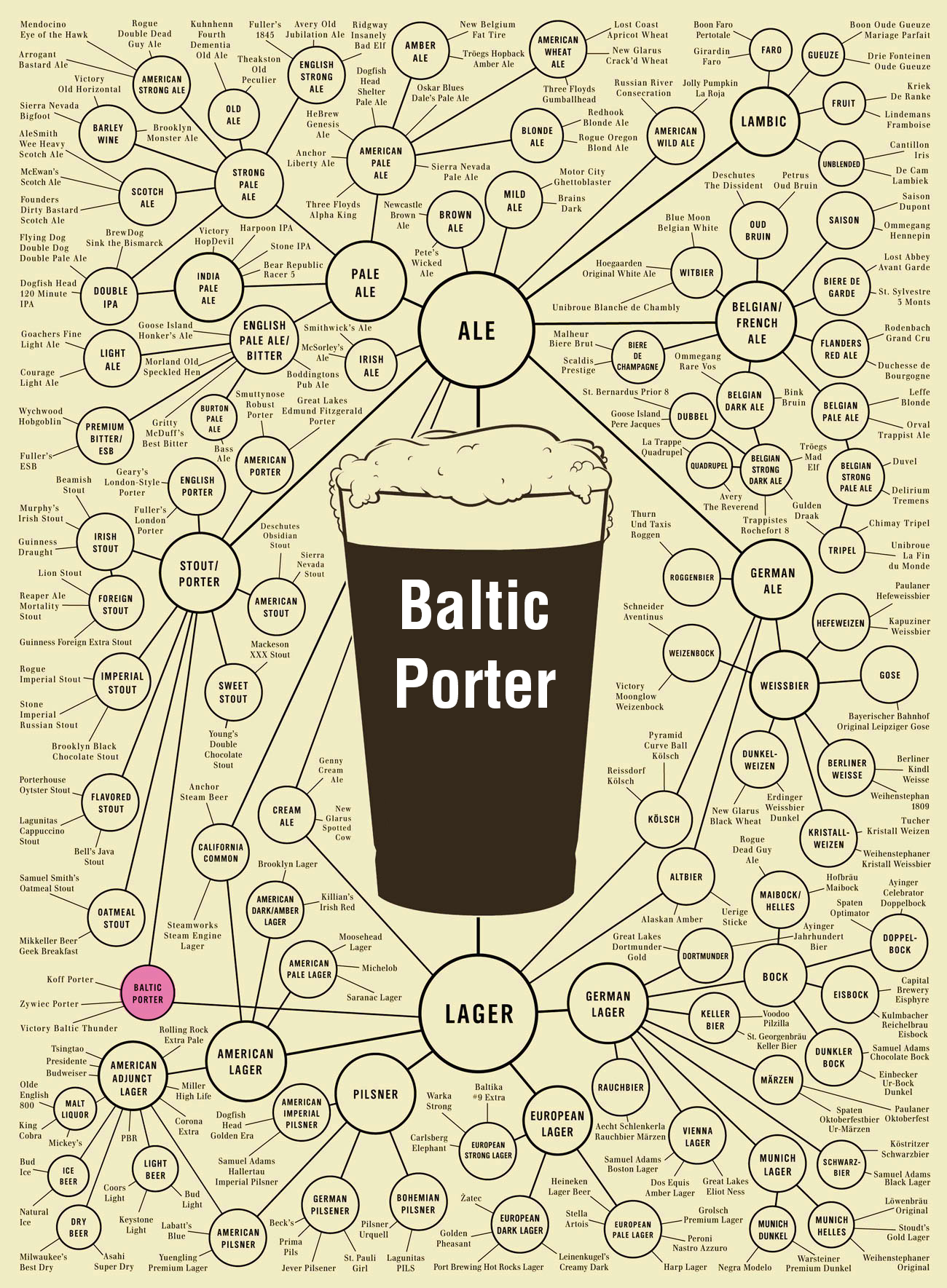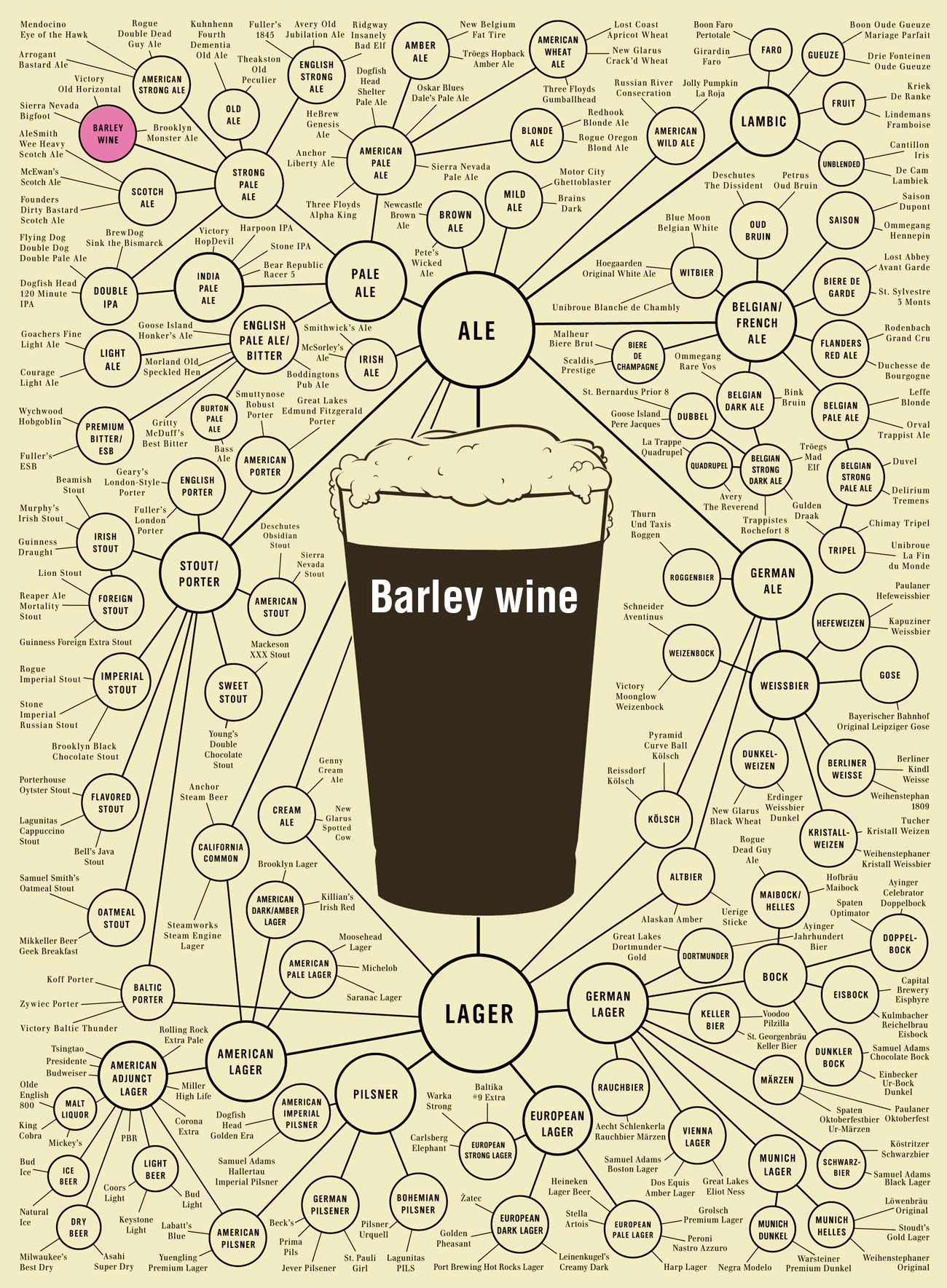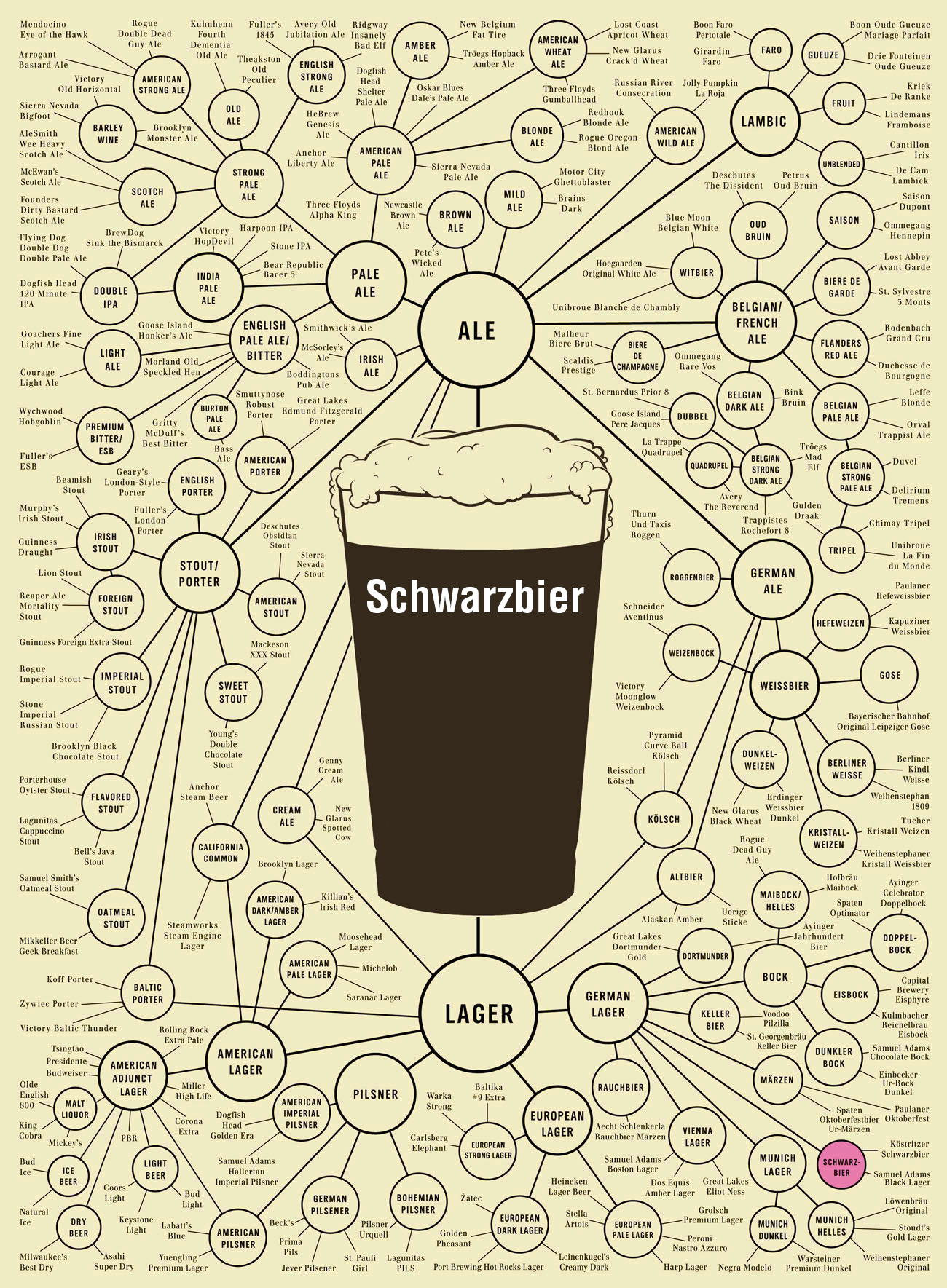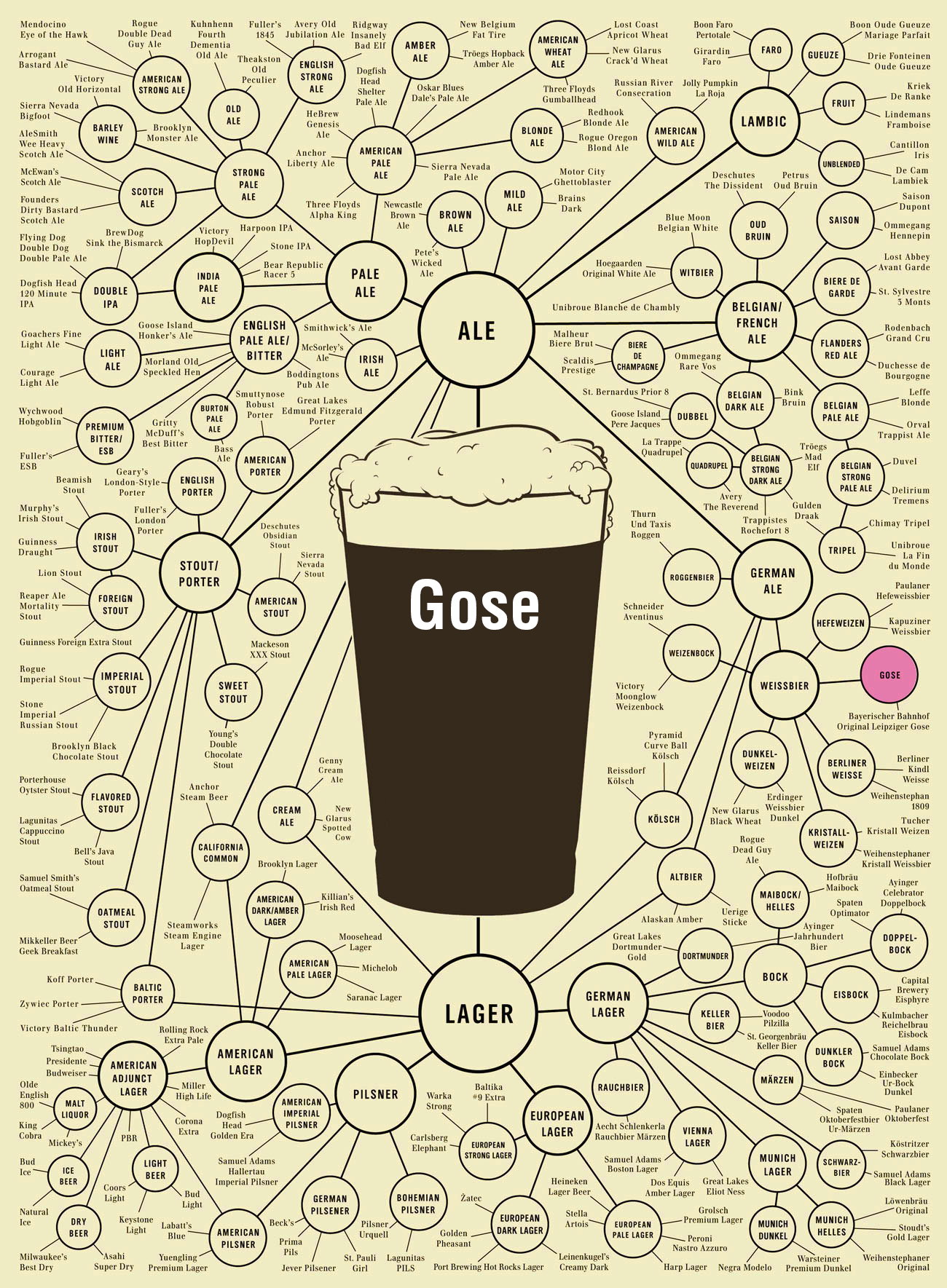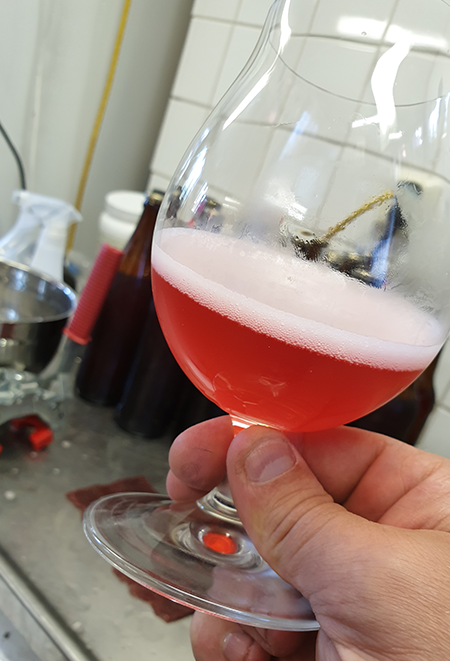OG: 1.044-1.52
FG: 1.008-1.012
ABV: 4,6-5,6
IBU: 18-30
EBC: 60-600
Mörk torr lager
Hantverksöl från Halland
- Std Sortiment
- Säsongsöl
- Ölstilsprojektet
- Sammarbeten
- Alla öl
Ugglarp Lezak
Bohemian Pilsner
Började som ett försök att klona Pilsner Urquell men har ledit vidare till en mer traditionell Tjeckisk Lezak.
ABV 4,6%
IBU 40,8
MALT: Pilsner Malt, Vienna Malt, Cara-Pils, Munich
JÄST Czech Pilsner Lager
HUMLE Magnum, Saaz
FÖRPAKNING
SEK 25
Session IPA
IPA
ABV: 4,6% Bitterness: 40,8 IBUs Color: 7,2 EBC Co2Vol: 2,3
Malt: Pilsner Malt, Vienna Malt, Cara-Pils, Munich
Humle: Magnum, Saaz
Jäst: Czech Pilsner Lager
SEK 35
Saison French Kiss
Saison
ABV: 4,6% Bitterness: 40,8 IBUs Color: 7,2 EBC Co2Vol: 2,3
Malt: Pilsner Malt, Vienna Malt, Cara-Pils, Munich
Humle: Magnum, Saaz
Jäst: Czech Pilsner Lager
SEK 25
Pollo de Playa
DIPA
Dubbel Indian Pale Ale
Receptet är inspererat av Stigbergets Bird in Hand. Jimmy mailade till Stigberget och fick efter ca en månad svar med grundreceptet.
SEK 45
Brut IPA
Dry IPA
Indian Pale Ale gjord med ris och majs, jäst med enzymer för en supertorr smak. Torrhumlad med okristliga mängder Mosaic humle.
SEK 45
Belgian Pale Ale
BJCP 24B
Belgian Pale Ale
Overall Impression: A moderately malty, somewhat fruity,
easy-drinking, copper-colored Belgian ale that is somewhat less
aggressive in flavor profile than many other Belgian beers. The
malt character tends to be a bit biscuity with light toasty,
honey-like, or caramelly components; the fruit character is
noticeable and complementary to the malt. The bitterness level
is generally moderate, but may not seem as high due to the
flavorful malt profile.
Aroma: Moderate malt aroma, which can be a combination of
toasty, biscuity, or nutty, possibly with a touch of light caramel
or honey. Moderate to moderately high fruitiness with an
orange- or pear-like character. Low to moderate strength hop
character (spicy, herbal, or floral) optionally blended with
background level peppery, spicy phenols. The hop character is
lower in balance than the malt and fruitiness.
Appearance: Amber to copper in color. Clarity is very good.
Creamy, rocky, white head often fades more quickly than other
Belgian beers.
Flavor: Has an initial soft, smooth, moderately malty flavor
with a variable profile of toasty, biscuity, nutty, light caramel
and/or honey notes. Moderate to moderately high fruitiness,
sometimes orange- or pear-like. Relatively light (medium-low
to low) spicy, herbal, or floral hop character. The hop bitterness
is medium-high to medium-low, and is optionally enhanced by
low to very low amounts of peppery phenols. There is a dry to
balanced finish, with hops becoming more pronounced in the
aftertaste of those with a drier finish. Fairly well balanced
overall, with no single component being high in intensity; malt
and fruitiness are more forward initially with a supportive
bitterness and drying character coming on late.
Mouthfeel: Medium to medium-light body. Smooth palate.
Alcohol level is restrained, and any warming character should
be low if present. Medium to medium-high carbonation.
Comments: Most commonly found in the Flemish provinces
of Antwerp and Brabant. Considered “everyday” beers
(Category I). Compared to their higher alcohol Category S
cousins, they are Belgian “session beers” for ease of drinking.
Nothing should be too pronounced or dominant; balance is the
key. Yeast character generally more subtle than many Belgian
beers, with some of the fruitiness being hop-driven.
History: Produced by breweries with roots as far back as the
mid-1700s, the most well-known examples were perfected after
the Second World War with some influence from Britain,
including hops and yeast strains.
Characteristic Ingredients: Pilsner or pale ale malt
contributes the bulk of the grist with (cara) Vienna and Munich
malts adding color, body and complexity. Sugar is not
commonly used as high gravity is not desired. Saazer-type
hops, Styrian Goldings, East Kent Goldings or Fuggles are
commonly used. Yeasts prone to moderate production of
phenols are often used but fermentation temperatures should
be kept moderate to limit this character.
Style Comparison: Fairly similar to pale ales from England
(Strong Bitter category), typically with a slightly different yeast
character and a more varied malt profile. Less yeast character
than many other Belgian beers, though.
Vital Statistics: OG: 1.048 – 1.054
IBUs: 20 – 30 FG: 1.010 – 1.014
SRM: 8 – 14 ABV: 4.8 – 5.5%
Commercial Examples: De Koninck, De Ryck Special, Palm
Dobble, Palm Speciale
Tags: standard-strength, amber-color, top-fermented,
western-europe, traditional-style, pale-ale-family, balanced
SEK 50
Altbier
BJCP 7B
Overall Impression: A well-balanced, well-attenuated, bitter
yet malty, clean, and smooth, amber- to copper-colored
German beer. The bitterness is balanced by the malt richness,
but the malt intensity and character can range from moderate
to high (the bitterness increases with the malt richness).
Aroma: Clean yet robust and complex aroma of grainy-rich
malt and spicy hops with restrained (low to medium-low) fruity
esters. The malt character reflects German base malt varieties,
with rich baked bread and nutty-toasty bread crust notes. The
hop aroma may vary from moderate to low, and can have a
peppery, spicy, floral, herbal or perfumy character associated
with Saazer-type hops.
Appearance: The color ranges from light amber to deep
copper color, stopping short of brown; bronze-orange is most
common. Brilliant clarity. Thick, creamy, long-lasting off-white
head.
Flavor: Assertive hop bitterness well balanced by a sturdy yet
clean and crisp malt character. The malt presence is moderated
by medium-high to high attenuation, but considerable rich,
complex, and somewhat grainy malt flavors can remain. Some
fruity esters (especially cherry-like) may survive the lagering
period. A long-lasting, medium-dry to dry, bittersweet or nutty
finish reflects both the hop bitterness and malt complexity.
Spicy, peppery or floral hop flavor can be moderate to low. No
roasted malt flavors or harshness. The apparent bitterness level
is sometimes masked by the malt character; the bitterness can
seem as low as moderate if the finish is not very dry. Light
sulfury or minerally character optional.
Mouthfeel: Medium-bodied. Smooth. Medium to mediumhigh carbonation, although can be lower when served from the
cask. Astringency low to none. Despite being very full of flavor,
is light-bodied enough to be consumed as a gravity-fed session
beer in its home brewpubs in Düsseldorf.
Comments: A top-fermented lagered beer, fermented at cool
ale temperature (59–68 °F), often conditioned at bottomfermentation temperatures (about 50 °F) and then lagered at
cold temperatures to produce a cleaner, smoother palate than
is typical for most ales. Zum Uerige is a wonderful beer, but
much more aggressively bitter and complex than most other
German examples. It may be like the Fuller’s ESB of the strong
bitter category – well-known but somewhat of a stylistic
outlier. Do not judge all Altbiers as if they were Zum Uerige
clones; allow for a more balanced bitterness in the beer (25–35
IBUs is more typical for most other German examples).
Stronger sticke and doppelsticke beers should not be entered
here.
BJCP Beer Style Guidelines – 2015 Edition 13
History: The traditional style of beer from Düsseldorf. “Alt”
refers to the “old” style of brewing (i.e., using top-fermenting
yeast) that was common before bottom-fermenting lager
brewing became popular. Predates the isolation of bottomfermenting yeast strains, though it approximates many
characteristics of bottom-fermenting lager beers. Many of the
classic examples can be found in brewpubs in the Altstadt (“old
town”) section of Düsseldorf.
Characteristic Ingredients: Grists vary, but usually consist
of German base malts (usually Pils, sometimes Munich) with
small amounts of crystal, chocolate, and/or black malts used to
adjust color. Occasionally will include some wheat, including
roasted wheat. Spalt hops are traditional, but other Saazer-type
hops can also be used. Clean, highly attenuative ale yeast. A
step mash or decoction mash program is traditional.
Style Comparison: More bitter and malty than international
amber lagers. Somewhat similar to California Common, both in
production technique and finished flavor and color, though not
in ingredients.
Vital Statistics: OG: 1.044 – 1.052
IBUs: 25 – 50 FG: 1.008 – 1.014
SRM: 11 – 17 ABV: 4.3 – 5.5%
Commercial Examples: Bolten Alt, Diebels Alt, Füchschen
Alt, Original Schlüssel Alt, Schlösser Alt, Schumacher Alt,
Uerige Altbier
Tags: standard-strength, amber-color, top-fermented, lag
SEK 50
Baltic Porter
BJCP 9C
Overall Impression: A Baltic Porter often has the malt
flavors reminiscent of an English porter and the restrained
roast of a schwarzbier, but with a higher OG and alcohol
content than either. Very complex, with multi-layered malt and
dark fruit flavors.
Aroma: Rich malty sweetness often containing caramel,
toffee, nutty to deep toast, and/or licorice notes. Complex
alcohol and ester profile of moderate strength, and reminiscent
of plums, prunes, raisins, cherries or currants, occasionally
with a vinous Port-like quality. Some darker malt character
that is deep chocolate, coffee or molasses but never burnt. No
hops. No sourness. Very smooth.
Appearance: Dark reddish-copper to opaque dark brown (not
black). Thick, persistent tan-colored head. Clear, although
darker versions can be opaque.
Flavor: As with aroma, has a rich malty sweetness with a
complex blend of deep malt, dried fruit esters, and alcohol. Has
a prominent yet smooth schwarzbier-like roasted flavor that
stops short of burnt. Mouth-filling and very smooth. Clean
lager character. Starts sweet but darker malt flavors quickly
dominates and persists through finish. Just a touch dry with a
hint of roast coffee or licorice in the finish. Malt can have a
caramel, toffee, nutty, molasses and/or licorice complexity.
Light hints of black currant and dark fruits. Medium-low to
medium bitterness from malt and hops, just to provide
balance. Hop flavor from slightly spicy hops ranges from none
to medium-low.
Mouthfeel: Generally quite full-bodied and smooth, with a
well-aged alcohol warmth. Medium to medium-high
carbonation, making it seem even more mouth-filling. Not
heavy on the tongue due to carbonation level.
Comments: May also be described today as an Imperial
Porter, although heavily roasted or hopped versions are not
appropriate for this style. Most versions are in the 7–8.5% ABV
range. Danish breweries often refer to them as Stouts, which
indicates their historic lineage from the days when Porter was
used as a generic name for Porter and Stout.
History: Traditional beer from countries bordering the Baltic
Sea, developed indigenously after higher-gravity export brown
or imperial stouts from England were established. Historically
top-fermented, many breweries adapted the recipes for
bottom-fermenting yeast along with the rest of their
production.
Characteristic Ingredients: Generally lager yeast (cold
fermented if using ale yeast, as is required when brewed in
Russia). Debittered chocolate or black malt. Munich or Vienna
base malt. Continental hops (Saazer-type, typically). May
contain crystal malts and/or adjuncts. Brown or amber malt
common in historical recipes.
Style Comparison: Much less roasted and smoother than an
Imperial Stout, typically with less alcohol. Lacks the roasty
qualities of stouts in general, more taking on the roasted-butnot-burnt characteristics of a schwarzbier. Quite fruity
compared to other porters. Higher alcohol than other porters.
Vital Statistics: OG: 1.060 – 1.090
IBUs: 20 – 40 FG: 1.016 – 1.024
SRM: 17 – 30 ABV: 6.5 – 9.5%
Commercial Examples: Aldaris Porteris, Baltika #6 Porter,
Devils Backbone Danzig, Okocim Porter, Sinebrychoff Porter,
Zywiec Porter
Tags: high-strength, dark-color, any-fermentation, lager
SEK 50
Barley Wine (American)
BJCP 22C
American Barleywine
Overall Impression: A well-hopped American interpretation
of the richest and strongest of the English ales. The hop
character should be evident throughout, but does not have to
be unbalanced. The alcohol strength and hop bitterness often
combine to leave a very long finish.
Aroma: Hop character moderate to assertive and often
showcases citrusy, fruity, or resiny New World varieties
(although other varieties, such as floral, earthy or spicy English
varieties or a blend of varieties, may be used). Rich maltiness,
with a character that may be sweet, caramelly, bready, or fairly
neutral. Low to moderately-strong fruity esters and alcohol
aromatics. However, the intensity of aromatics often subsides
with age. Hops tend to be nearly equal to malt in the aroma,
with alcohol and esters far behind.
Appearance: Color may range from light amber to medium
copper; may rarely be as dark as light brown. Often has ruby
highlights. Moderately-low to large off-white to light tan head;
may have low head retention. May be cloudy with chill haze at
cooler temperatures, but generally clears to good to brilliant
clarity as it warms. The color may appear to have great depth,
as if viewed through a thick glass lens. High alcohol and
viscosity may be visible in “legs” when beer is swirled in a glass.
Flavor: Strong, rich malt flavor with a noticeable hop flavor
and bitterness in the balance. Moderately-low to moderatelyhigh malty sweetness on the palate, although the finish may be
somewhat sweet to quite dry (depending on aging). Hop
bitterness may range from moderately strong to aggressive.
While strongly malty, the balance should always seem bitter.
Moderate to high hop flavor (any variety, but often showing a
range of New World hop characteristics). Low to moderate
fruity esters. Noticeable alcohol presence, but well-integrated.
Flavors will smooth out and decline over time, but any oxidized
character should be muted (and generally be masked by the
hop character). May have some bready or caramelly malt
flavors, but these should not be high; roasted or burnt malt
flavors are inappropriate.
Mouthfeel: Full-bodied and chewy, with a velvety, luscious
texture (although the body may decline with long
conditioning). Alcohol warmth should be noticeable but
smooth. Should not be syrupy and under-attenuated.
Carbonation may be low to moderate, depending on age and
conditioning.
Comments: Sometimes known as “Barley Wine” or
“Barleywine style ale” (the latter due to legal requirements, not
brewery preference).
History: Usually the strongest ale offered by a brewery, often
associated with the winter or holiday season and vintage-dated.
As with many American craft beer styles, derived from English
examples but using American ingredients and featuring a much
more forward hop profile. One of the first American craft beer
versions was Anchor Old Foghorn, first brewed in 1975. Sierra
Nevada Bigfoot, first brewed in 1983, set the standard for the
hop-forward style of today. The story goes that when Sierra
Nevada first sent Bigfoot out for lab analysis, the lab called and
said, “your barleywine is too bitter” – to which Sierra Nevada
replied, “thank you.”
Characteristic Ingredients: Well-modified pale malt
should form the backbone of the grist. Some specialty or
character malts may be used. Dark malts should be used with
great restraint, if at all, as most of the color arises from a
lengthy boil. New World hops are common, although any
varieties can be used in quantity. Generally uses an attenuative
American ale yeast.
Style Comparison: The American version of the Barleywine
tends to have a greater emphasis on hop bitterness, flavor and
aroma than the English Barleywine, and often features
American hop varieties. Typically paler than the darker English
Barleywines (and lacking in the deeper malt flavors) but darker
than the golden English Barleywines. Differs from a Double
IPA in that the hops are not extreme, the malt is more forward,
and the body is fuller and often richer. An American
Barleywine typically has more residual sweetness than a
Double IPA, which affects the overall drinkability (sipping vs.
drinking).
Vital Statistics: OG: 1.080 – 1.120
IBUs: 50 – 100 FG: 1.016 – 1.030
SRM: 10 – 19 ABV: 8.0 – 12.0%
Commercial Examples: Avery Hog Heaven Barleywine,
Anchor Old Foghorn, Great Divide Old Ruffian, Rogue Old
Crustacean, Sierra Nevada Bigfoot, Victory Old Horizontal
Tags: very-high-strength, amber-color, top-fermented, northamerica, craft-style, strong-ale-family, bitter, hoppy
SEK 50
European Pale Lager
BJCP 2A
International Pale Lager*
Overall Impression: A highly-attenuated pale lager without
strong flavors, typically well-balanced and highly carbonated.
Served cold, it is refreshing and thirst-quenching.
Aroma: Low to medium-low malt aroma, which can be grainymalty or slightly corny-sweet. Hop aroma may range from very
low to a medium, spicy or floral hop presence. While a clean
fermentation profile is generally most desirable, low levels of
yeast character (such as a light apple fruitiness) are not a fault.
A light amount of DMS or corn aroma is not a fault.
Appearance: Pale straw to gold color. White, frothy head may
not be long lasting. Very clear.
Flavor: Low to moderate levels of grainy-malt flavor, with a
crisp, dry, well-attenuated finish. The grain character can be
somewhat neutral, or show a light bready-crackery quality or
up to moderate corny or malty sweetness. Hop flavor ranges
from none to medium levels, and often showing a floral, spicy,
or herbal character if detected. Hop bitterness at medium-low
to medium level. Balance may vary from slightly malty to
slightly bitter, but is relatively close to even. Neutral aftertaste
with light malt and sometimes hop flavors. A light amount of
DMS is not a fault.
Mouthfeel: Light to medium body. Moderately high to highly
carbonated. Can have a slight carbonic bite on the tongue.
Comments: International lagers tend to have fewer adjuncts
than standard American lagers. They may be all-malt, although
strong flavors are still a fault. A broad category of international
mass-market lagers ranging from up-scale American lagers to
the typical “import” or “green bottle” international beers found
in America and many export markets. Often confusingly
labeled as a “Pilsner.” Any skunkiness in commercial beers
from being lightstruck in a green bottle is a mishandling fault,
not a characteristic of the style.
History: In the United States, developed as a premium
version of the standard American lager, with a similar history.
Outside the United States, developed either as an imitation of
American style lagers, or as a more accessible (and often drier
and less bitter) version of a Pilsner-type beer. Often heavily
marketed and exported by large industrial or multi-national
breweries.
Characteristic Ingredients: Two- or six-row barley. May
use rice, corn, or sugar as adjuncts, or may be all malt.
Style Comparison: Generally more bitter and filling than
American lager. Less hoppy and bitter than a German Pils. Less
body, malt flavor, and hop character than a Czech Premium
Pale Lager. More robust versions can approach a Munich
Helles in flavor, although with more of an adjunct quality.
Vital Statistics: OG: 1.042 – 1.050
IBUs: 18 – 25 FG: 1.008 – 1.012
SRM: 2 – 6 ABV: 4.6 – 6.0%
Commercial Examples: Asahi Super Dry, Birra Moretti,
Corona Extra, Devils Backbone Gold Leaf Lager, Full Sail
Session Premium Lager, Heineken, Red Stripe, Singha
Tags: standard-strength, pale-color, bottom-fermented,
SEK 50
Schwarzbier
BJCP 8B
Overall Impression: A dark German lager that balances
roasted yet smooth malt flavors with moderate hop bitterness.
The lighter body, dryness, and lack of a harsh, burnt, or heavy
aftertaste helps make this beer quite drinkable.
Aroma: Low to moderate malt, with low aromatic malty
sweetness and/or hints of roast malt often apparent. The malt
can be clean and neutral or moderately rich and bready, and
may have a hint of dark caramel. The roast character can be
somewhat dark chocolate- or coffee-like but should never be
burnt. A low spicy, floral, or herbal hop aroma is optional.
Clean lager yeast character, although a light sulfur is possible.
Appearance: Medium to very dark brown in color, often with
deep ruby to garnet highlights, yet almost never truly black.
Very clear. Large, persistent, tan-colored head.
Flavor: Light to moderate malt flavor, which can have a clean,
neutral character to a moderately rich, bread-malty quality.
Light to moderate roasted malt flavors can give a bitterchocolate palate that lasts into the finish, but which are never
burnt. Medium-low to medium bitterness, which can last into
the finish. Light to moderate spicy, floral, or herbal hop flavor.
Clean lager character. Aftertaste tends to dry out slowly and
linger, featuring hop bitterness with a complementary but
subtle roastiness in the background. Some residual sweetness
is acceptable but not required.
Mouthfeel: Medium-light to medium body. Moderate to
moderately-high carbonation. Smooth. No harshness or
astringency, despite the use of dark, roasted malts.
Comments: Literally means “black beer” in German. While
sometimes called a “black Pils,” the beer is rarely as dark as
black or as bitter as a Pils; don’t expect strongly roasted,
porter-like flavors.
History: A regional specialty from Thuringia, Saxony and
Franconia in Germany. History is a bit sketchy, but is
suspected of being originally a top-fermented beer. Popularity
grew after German reunification. Served as the inspiration for
black lagers brewed in Japan.
Characteristic Ingredients: German Munich malt and/or
Pilsner malts for the base, supplemented by a judicious use of
roasted malts (such as Carafa types) for the dark color and
subtle roast flavors. Huskless dark roasted malts can add roast
flavors without burnt flavors. German hop varieties and clean
German lager yeasts are traditional.
Style Comparison: In comparison with a Munich Dunkel,
usually darker in color, drier on the palate, lighter in body, and
with a noticeable (but not high) roasted malt edge to balance
the malt base. Should not taste like an American Porter made
with lager yeast. Drier, less malty, with less hop character than
a Czech Dark Lager.
Vital Statistics: OG: 1.046 – 1.052
IBUs: 20 – 30 FG: 1.010 – 1.016
SRM: 17 – 30 ABV: 4.4 – 5.4%
Commercial Examples: Devils Backbone Schwartz Bier,
Einbecker Schwarzbier, Eisenbahn Dunkel, Köstritzer
Schwarzbier, Mönchshof Schwarzbier, Nuezeller Original
Badebier
Tags: standard-strength, dark-color, bottom-fermented,
lagered, cen
SEK 50
Gueuze
BJCP 23E
Overall Impression: A complex, pleasantly sour but
balanced wild Belgian wheat beer that is highly carbonated and
very refreshing. The spontaneous fermentation character can
provide a very interesting complexity, with a wide range of wild
barnyard, horse blanket, or leather characteristics
intermingling with citrusy-fruity flavors and acidity.
Aroma: A moderately sour aroma blends with aromas
described as barnyard, leather, earthy, goaty, hay, horsey, and
horse blanket. While some may be more dominantly sour,
balance is the key and denotes a better gueuze. Commonly
fruity with aromas of citrus fruits (often grapefruit), apples or
other light fruits, rhubarb, or honey. A very mild oak aroma is
considered favorable. An enteric, smoky, cigar-like, or cheesy
aroma is unfavorable. No hop aroma.
Appearance: Golden color, with excellent clarity and a thick,
rocky, mousse-like, white head that seems to last forever.
Always effervescent.
Flavor: A moderately sour character is classically in balance
with the malt, wheat and barnyard characteristics. A low,
complementary sweetness may be present but higher levels are
not traditional. While some may be more dominantly sour,
balance is the key and denotes a better gueuze. A varied fruit
flavor is common, and can have a honey-like character. A mild
vanilla and/or oak flavor is occasionally noticeable. The malt is
generally low and bready-grainy. An enteric, smoky or cigarlike character is undesirable. Hop bitterness is generally absent
but a very low hop bitterness may occasionally be perceived;
sourness provides most of the balance. Crisp, dry, and tart
finish. No hop flavor.
Mouthfeel: Light to medium-light body. In spite of the low
finishing gravity, the many mouth-filling flavors prevent the
beer from feeling like water. Has a low to high tart, puckering
quality without being sharply astringent. Some versions have a
light warming character. Highly carbonated.
Comments: Gueuze is traditionally produced by mixing one,
two, and three-year old lambic. “Young” lambic contains
fermentable sugars while old lambic has the characteristic
“wild” taste of the Senne River valley. A noticeable vinegary or
cidery character is considered a fault by Belgian brewers. A
good gueuze is not the most pungent, but possesses a full and
tantalizing bouquet, a sharp aroma, and a soft, velvety flavor.
Lambic is served uncarbonated, while gueuze is served
effervescent. Products marked oude or ville are considered
most traditional.
History: Spontaneously fermented wild ales from the area in
and around Brussels (the Senne Valley) stem from a farmhouse
brewing and blending tradition several centuries old. The
number of producers is constantly dwindling and some
producers are untraditionally sweetening their products (postfermentation) to make them more palatable to a wider
audience. These guidelines describe the traditional dry
product.
Characteristic Ingredients: Unmalted wheat (30-40%),
Pilsner malt and aged hops (3 years) are used. The aged hops
are used more for preservative effects than bitterness, and
makes actual bitterness levels difficult to estimate.
Traditionally these beers are spontaneously fermented with
naturally occurring yeast and bacteria in predominately oaken
barrels. The barrels used are old and have little oak character,
so don’t expect a fresh or forward oak character – more neutral
is typical. Home-brewed and craft-brewed versions are more
typically made with pure cultures of yeast commonly including
Saccharomyces, Brettanomyces, Pediococcus and Lactobacillus
in an attempt to recreate the effects of the dominant microbiota
of Brussels and the surrounding countryside of the Senne River
valley. Cultures taken from bottles are sometimes used but
there is no simple way of knowing what organisms are still
viable.
Style Comparison: More complex and carbonated than a
lambic. The sourness isn’t necessarily higher, but it tends to
have more of a well-developed wild character.
Vital Statistics: OG: 1.040 – 1.060
IBUs: 0 – 10 FG: 1.000 – 1.006
SRM: 3 – 7 ABV: 5.0 – 8.0%
Commercial Examples: Boon Oude Gueuze, Boon Oude
Gueuze Mariage Parfait, Cantillon Gueuze, De Cam Gueuze, De
Cam/Drei Fonteinen Millennium Gueuze, Drie Fonteinen Oud
Gueuze, Girardin Gueuze (Black Label), Hanssens Oude
Gueuze, Lindemans Gueuze Cuvée René, Mort Subite
(Unfiltered) Gueuze, Oud Beersel Oude Gueuze
Tags: high-strength, pale-color, wild-fermented, western
SEK 50
Kombucha
Fermenterat Te
Two turntables and a microphone are all you need to put together an incredible set. Mix your own music live or play the classics on this gorgeous turntable by Sony.
SEK 25




Ölinformation
lördag, februari 15, 2020
Harley Wine Bryggd 15 Februari 2020 En American Barleywine som lagrats i nästan ett år för att alla komplexa smaker ska gifta sig. OG 1.110 FG 1.017 ABV 12,6% IBU 94,4 EBC 36,3 Serveras vid 12-14°C. Kan lagras upp till 36 månader. Ingredienser: Malt: Pale Ale, Biscuit, Carahell Humle: Centennial, Chinook, Cascade
tisdag, augusti 11, 2020
Weyermann Bohemian Pilsner Bryggd 25 Juli 2020 En Böhmisk Pilsner baserad på ett recept från mälteriet Weyermann som levererar majoriteten av den malt vi använder. Förutom Pilsnermalt har vi lagt till 2,2% Carabohemia som ger en mörkare färg och en brödigare maltsmak. OG 1.046 FG 1.011 ABV 4,6% IBU 36,5 EBC 9,4 Serveras vid 6-8°C. Kan lagras upp till 12 månader. Ingredienser: Malt: Golvmältad Böhmisk Pilsnermalt, Carabohemia Humle: Magnum, Saaz
Bryggnytt
måndag, februari 17, 2020
Senaste bryggningarna Harley Wine 15 Februari En Amerikansk Barley Wine som ska ligga till sig ett år. OG 1.110 Est.FG 1.038 Est ABV 10%> IBU 95 EBC 36 Garageportsöl 15 Februari Vår version av...
söndag, februari 09, 2020
Senaste bryggningarna Punkalager 1 Februari Baserad på Pistonhead Flat Tire OG 1.051 Est.FG 1.007 Belgian Gold 1 Februari En belgisk blond i projektet att brygga alla typer av öl. OG 1.063 Est.FG...
fredag, januari 24, 2020
Man kan inte utala sig om något innan man testat. Därför ska vi brygga alla kända ölstilar som finns och du kan vara med på resan! Vi kommer lista vilka stilar som ligger i pipen och tipsa om...
© 2020 by Buffalo Bay Brewery
